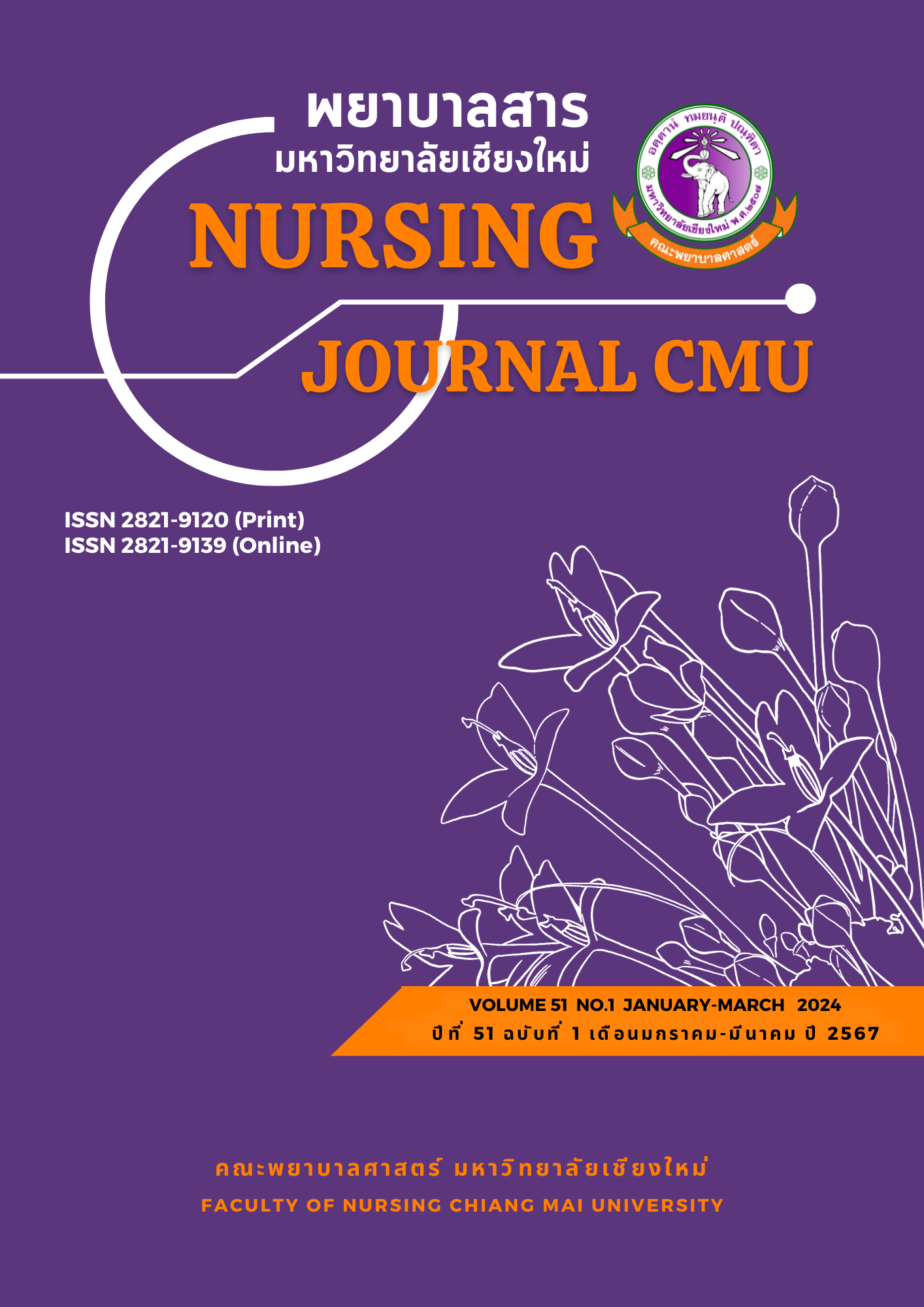Quality Improvement of the Well-Child Clinic Care Model on Parental Health Literacy and Child Health Outcomes
Keywords:
Well-child clinic, Early childhood, Parental health literacy, Child health outcome, BreastfeedingAbstract
The Well-Child Clinic plays an important role in promoting good health and development during early childhood. Providing a Learning process for parents in the clinic can enhance the knowledge, understanding, and ability of parents to raise their children correctly and appropriately. This developmental research aimed to develop a care model on parental health literacy and child health outcomes, for a well-child clinic at a tertiary hospital. The Department of Health’s (Ministry of Public Health) guidelines for implementing a well-baby clinic and Nutbeam and Pengchan’s concepts of promoting health literacy were used as the guidelines for developing the model. The purposive sampling consisted of 30 parents of early childhood-aged children, and 30 early childhoods. The research was conducted in four phases: 1) analyzing the situation, 2) developing the service model, 3) implementing the developed model, and 4) evaluating the results. The research instruments consisted of the well-child clinic care model and a program to promote parental health literacy. The data collection tools consisted of a demographic form, a focus group interview form, a health literacy questionnaire, a breastfeeding record form, a child health record form, a growth chart, and a Developmental Surveillance and Promotion Manual (DSPM). Data were analyzed using descriptive statistics and paired t-test.
The results show that parents' health literacy improved. The mean overall health literacy score after the experiment (Mean = 172.03, SD = 18.23) was significantly higher than before the experiment (Mean = 154, SD = 14.02) (t = -7.08, p < 0.001). All infants received continuous breastfeeding. After parents participated in the program, however, child health outcomes including nutritional status, oral health, and development remained the same as before participation.
Well-Child Clinic Care Model development could increase parental health literacy in raising their children which may have a positive impact on early childhood health outcomes.
References
Buawangpong, N., Sirikul, W., Anukhro, C., Seesen, M., La-Up, A., & Siviroj, P. (2022). Health information sources influencing health literacy in different social contexts across age groups in Northern Thailand Citizens. International Journal of Environmental Research and Public Health, 19(10), 6051. https://doi.org/10.3390/ijerph19106051
Chanduaywit, W., & Phatchana, P. (2019). Situation of health service use: Differences between gender, age, and area. https://tdri.or.th/2019/01/%E0%B8%82%E0%B9%89%E0%B8%AD%E0%B8%A1%E0%B8%B9%E0%B8%A5%E0%B9%83%E0%B8%8A%E0%B9%89%E0%B8%9A%E0%B8%A3%E0%B8%B4%E0%B8%81%E0%B8%B2%E0%B8%A3%E0%B8%AA%E0%B8%B8%E0%B8%82%E0%B8%A0%E0%B8%B2%E0%B8%9E%E0%B8%AA/ (in Thai)
de Buhr, E., & Tannen, A. (2020). Parental health literacy and health knowledge, behaviours and outcomes in children: A cross-sectional survey. BMC Public Health, 20, 1096. https://doi.org/10.1186/s12889-020-08881-5
Department of Health. (2016). Parental school manual for their children (2nd ed.). New Thammada Press. https://hp.anamai.moph.go.th/th/manuals-of-official/download/?did=209043&id=91001&reload= (in Thai)
Department of Health. (2022). Guidelines for organizing services at the healthy children clinic. Office of printing affairs, War Vetarans Organization. https://hp.anamai.moph.go.th/th/manuals-of-official/download/?did=210512&id=95167&reload= (in Thai)
Department of Health. (2023). Information systems supporting health promotion and environmental health. https://dashboard.anamai.moph.go.th/ministry?year=2023 (in Thai)
Estacio, E. V., Nathan, L., & Protheroe, J. (2020). Celebrating the health literacy skills of parents: A photovoice study. Journal of Health Psychology. 25(10-11), 1522-1531. https://doi.org/10.1177/1359105318763494
Hillyer, G. C., Schmitt, K. M., Lizardo, M., Reyes, A., Bazan, M., Alvarez, M. C., Sandoval, R., Abdul, K., & Orjuela, M. A. (2017). Electronic communication channel use and health information source preferences among Latinos in Northern Manhattan. Journal of Community Health, 42(2), 349–357. https://doi.org/10.1007/s10900-016-0261-z
Laohapensang, P., & Chatiketu, P. (2022). Effectiveness of learning process model to improve oral health literacy among parents of early childhood in Health Promotion Center Region 1, Chiang Mai. Thai Dental Public Health Journal, 27, 28-40. https://he02.tci-thaijo.org/index.php/ThDPHJo/article/view/259216
Michou, M., Panagiotakos, D. B., & Costarelli, V. (2018). Low health literacy and excess body weight: A systematic review. Central European Journal of Public Health, 26(3), 234–241. https://doi.org/10.21101/cejph.a5172
Ministry of Public Health. (2023). Developmental surveillance and promotion manual (DSPM). War Veterans Organization. https://multimedia.anamai.moph.go.th/ebooks/dspm/
National Statistical Office. (2023). Thailand multiple indicator cluster survey 2022, survey findings report. https://www.unicef.org/thailand/reports/thailand-multiple-indicator-cluster-survey-2022 (in Thai)
Nutbeam, D. (2000). Health literacy as a public health goal: A challenge for contemporary health education and communication strategies in the 21st century. Health Promotion International, 15(3), 259-267. https://doi.org/10.1093/heapro/15.3.259
Nutbeam, D. (2008). The evolving concept of health literacy. Social Science and Medicine, 67(12), 2072-2078. https://doi.org/10.1016/j.socscimed.2008.09.050
Ono, S., Ogi, H., Ogawa, M., Nakamura, D., Nakamura T., & Izawa, K. P. (2021). Relationship between parents’ health literacy and children’s sleep problems in Japan. BMC Public Health, 21(1), 791. https://doi.org/10.1186/s12889-021-10864-z
Pengchan, W. (2017). Health literacy in the document for department of personnel capacity development workshop, health department, ministry of public health. Ministry of Public Health.
Potipiti, K. (2022). Health literacy of major caregivers and teachers/child caregivers about early childhood care in the health region 5. Journal of Khon Kaen Seventh Health Center, 15(1), 28-50. (in Thai)
Puapornpong, P., Aimjirakul, K., Chomtho, S., & Dumrongwongsiri, O. (2016). Clinical practice of breastfeeding. Beyond Enterprise. https://library.thaibf.com/handle/023548404.11/479
Sierra, M., & Cianelli, R. (2019). Health literacy in relation to health outcomes: A concept analysis. Nursing Science Quarterly, 32(4), 299-305. https://doi.org/10.1177/0894318419864328
Sriyasak, A., Ket-in, V., Chinglek, W., Nuttarugs, S., & Yamma, W. (2023). The effect of health literacy program on weight control behaviors of primary school students in Phetchaburi Province. Journal of Health Science Research, 17(1), 39-51. (in Thai)
Thongthai, T., Boonjeam, S., Puriso, P., Srimanon, N., & Deeunkong, L. (2023). Health literacy in early childhood rearing of parents in the health area 7. Thailand Journal of Health Promotion and Environmental Health, 46(1), 105-115. https://thaidj.org/index.php/tjha/issue/view/1022 (in Thai)
Wattanasiri, P., Supavitipatana, B., & Sriarporn, P. (2022). Health literacy and exclusive breastfeeding self-management of first-time mothers. Journal of Phrapokklao Nursing College, 33(2), 1-12. (in Thai)
Wicha, T., Chailangka, W., Somboon, L., Kaewkajorn, S., & Aryuyuen, B. (2023). Health literacy and care behaviors in preventing respiratory infection diseases among parents of preschool children in child development centers. Nursing Journal CMU, 50(2), 195-211. (in Thai)
World Health Organization. (1998). Health promotion glossary. https://www.who.int/publications/i/item/WHO-HPR-HEP-98.1
Downloads
Published
How to Cite
Issue
Section
License
Copyright (c) 2024 Nursing Journal CMU

This work is licensed under a Creative Commons Attribution-NonCommercial-NoDerivatives 4.0 International License.
บทความที่ได้รับการตีพิมพ์เป็นลิขสิทธิ์ของวารสารพยาบาลสาร
ข้อความที่ปรากฏในบทความแต่ละเรื่องในวารสารวิชาการเล่มนี้เป็นความคิดเห็นส่วนตัวของผู้เขียนแต่ละท่านไม่เกี่ยวข้องกับมหาวิทยาลัยเชียงใหม่ และคณาจารย์ท่านอื่นๆในมหาวิทยาลัยฯ แต่อย่างใด ความรับผิดชอบองค์ประกอบทั้งหมดของบทความแต่ละเรื่องเป็นของผู้เขียนแต่ละท่าน หากมีความผิดพลาดใด ๆ ผู้เขียนแต่ละท่านจะรับผิดชอบบทความของตนเองแต่ผู้เดียว






